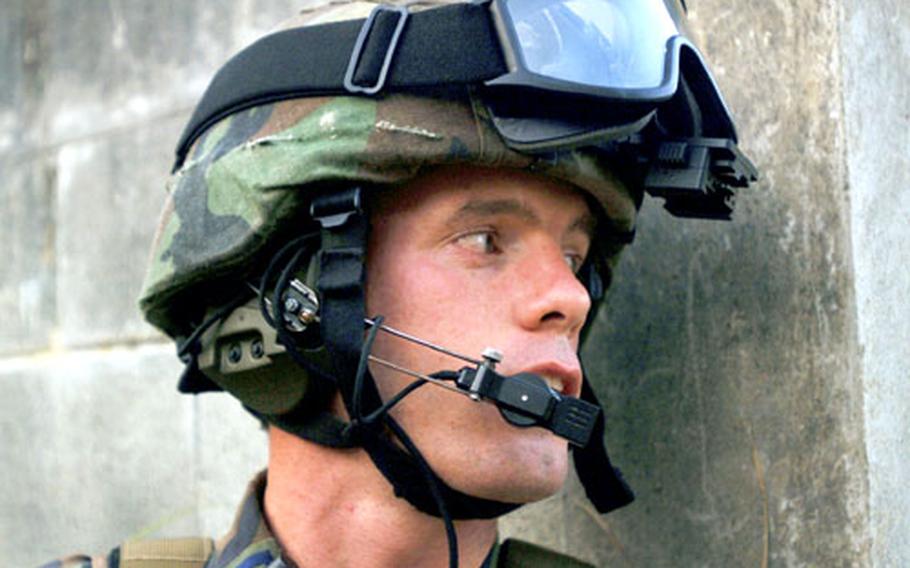
Capt. Charles Bris-Bois, a combat rescue officer from the 31st Rescue Squadron, Kadena Air Base, Japan, keeps an eye on “enemy forces” during a non-combatant evacuation exercise at Combat Town training area, Okinawa, Japan. He was taking part in Joint Air and Sea Exercise 2005. (Val Gempis / Courtesy of U.S. Air Force)
USS KITTY HAWK — More than 10,000 servicemembers are vying for air and sea supremacy this week during JASEX 2005, a joint exercise spanning hundreds of miles of ocean east of Okinawa.
The Joint Air and Sea Exercise brings the Navy’s ships and planes together with Air Force and Marine aircraft to practice everything from bombing tiny islands with nicknames like “the guitar pick” to dogfighting and search-and-rescue operations.
Mainly, participants are concentrating on “maritime interdiction” scenarios in which aircraft try to destroy and defend ships, said Rear Adm. Doug McClain, Carrier Strike Group Five commander.
“This is the highest-level exercise we can do,” McClain said. “It runs the entire spectrum of warfare, from subsurface up to our satellite link.”
For all the sophistication and high-tech weaponry, most of the scenario’s air objectives can be summed up simply: Outmaneuver the opponent and destroy the target.
But for that to happen, a massive support staff must prepare the aircraft for combat against their counterparts, designated “red” or “blue” depending on their objectives.
On the Kitty Hawk, preparation means 12-hour shifts for many of the sailors on the carrier’s 4.1-acre flight deck. Even during mild weather, they get exposed to enough scorching exhaust to make a jaunt through Iraq seem brisk in comparison.
The maintenance crews must work quickly; the planes spend 30 to 45 minutes on the deck for maintenance and refueling before they’re again ready to take to the skies.
On Thursday, the Kitty Hawk’s deck at times seemed like a conveyor belt of F/A-18 Hornet and Super Hornets grabbing arresting wires with their tailhooks and landing in succession at roughly one-minute intervals.
“They’re having a lot of fun today out there, getting this much flight time,” said Cmdr. Carl Chebi, commander of the VFA 192 Golden Dragons fighter squadron from Naval Air Facility Atsugi, Japan.
F/A-18 pilots aboard the Kitty Hawk fly once or twice per day during the exercise, usually for two to four hours.
Coordinating with aircraft from other services can be tricky at first because of the differing cultures and communication, Chebi said.
However, those troubles usually dissipate quickly, he said. Such differences also can help strengthen tactics and communication for each service, Air Force Capt. Brian Bell said Wednesday.
“We all have the same goals, but we each have things that we do a little differently,” he said.
Bell is one of several Kadena airmen taking part in the exercise, with airmen from Guam and a smattering of stateside F-15 Strike Eagle pilots. Okinawa’s III Marine Expeditionary Force sent aircraft to the USS Boxer.
Naval forces involved include the Kitty Hawk Carrier Strike Group, Destroyer Squadron 15, USS Boxer, the USNS Dahl and two submarines.
The Kitty Hawk has been deployed from Yokosuka Naval Base for about three months, sailing throughout Asia and recently taking part in Australia’s Talisman Saber exercise.